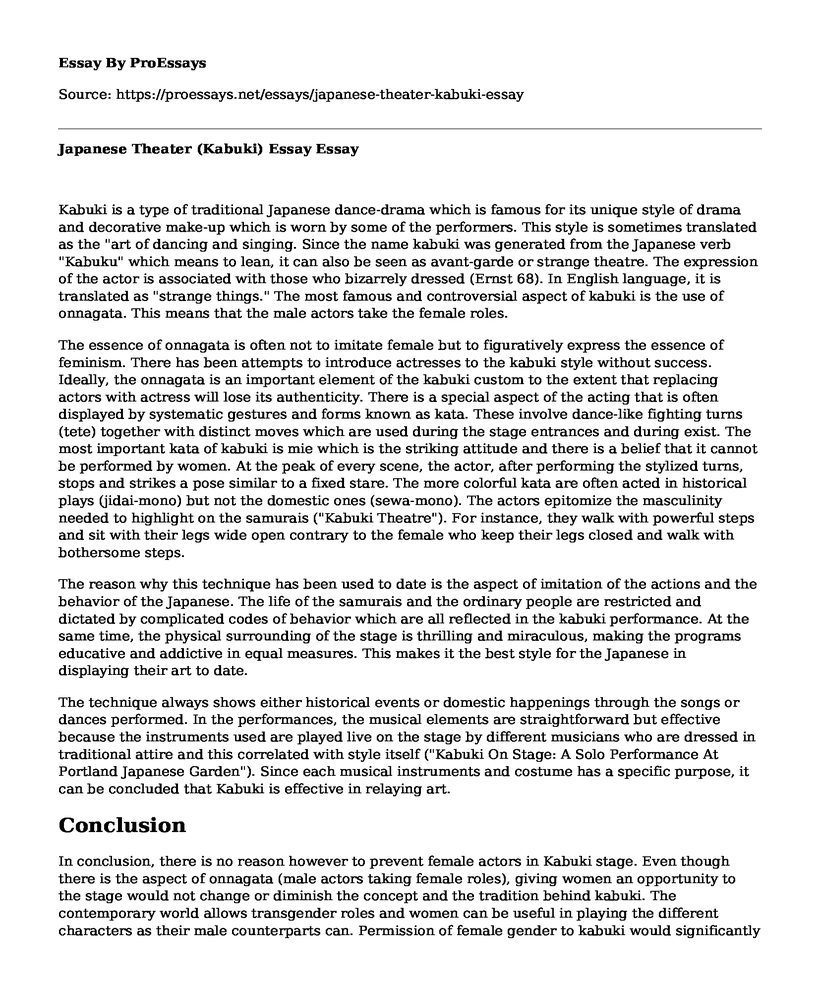Kabuki is a type of traditional Japanese dance-drama which is famous for its unique style of drama and decorative make-up which is worn by some of the performers. This style is sometimes translated as the "art of dancing and singing. Since the name kabuki was generated from the Japanese verb "Kabuku" which means to lean, it can also be seen as avant-garde or strange theatre. The expression of the actor is associated with those who bizarrely dressed (Ernst 68). In English language, it is translated as "strange things." The most famous and controversial aspect of kabuki is the use of onnagata. This means that the male actors take the female roles.
The essence of onnagata is often not to imitate female but to figuratively express the essence of feminism. There has been attempts to introduce actresses to the kabuki style without success. Ideally, the onnagata is an important element of the kabuki custom to the extent that replacing actors with actress will lose its authenticity. There is a special aspect of the acting that is often displayed by systematic gestures and forms known as kata. These involve dance-like fighting turns (tete) together with distinct moves which are used during the stage entrances and during exist. The most important kata of kabuki is mie which is the striking attitude and there is a belief that it cannot be performed by women. At the peak of every scene, the actor, after performing the stylized turns, stops and strikes a pose similar to a fixed stare. The more colorful kata are often acted in historical plays (jidai-mono) but not the domestic ones (sewa-mono). The actors epitomize the masculinity needed to highlight on the samurais ("Kabuki Theatre"). For instance, they walk with powerful steps and sit with their legs wide open contrary to the female who keep their legs closed and walk with bothersome steps.
The reason why this technique has been used to date is the aspect of imitation of the actions and the behavior of the Japanese. The life of the samurais and the ordinary people are restricted and dictated by complicated codes of behavior which are all reflected in the kabuki performance. At the same time, the physical surrounding of the stage is thrilling and miraculous, making the programs educative and addictive in equal measures. This makes it the best style for the Japanese in displaying their art to date.
The technique always shows either historical events or domestic happenings through the songs or dances performed. In the performances, the musical elements are straightforward but effective because the instruments used are played live on the stage by different musicians who are dressed in traditional attire and this correlated with style itself ("Kabuki On Stage: A Solo Performance At Portland Japanese Garden"). Since each musical instruments and costume has a specific purpose, it can be concluded that Kabuki is effective in relaying art.Conclusion
In conclusion, there is no reason however to prevent female actors in Kabuki stage. Even though there is the aspect of onnagata (male actors taking female roles), giving women an opportunity to the stage would not change or diminish the concept and the tradition behind kabuki. The contemporary world allows transgender roles and women can be useful in playing the different characters as their male counterparts can. Permission of female gender to kabuki would significantly enrich it. The play can improve imagination of the world.
Works cited
"Kabuki On Stage: A Solo Performance At Portland Japanese Garden." YouTube. N.p., 2018. Web. 10 Apr. 2018.
Ernst, Earle. The Kabuki Theatre. Honolulu: University Press of Hawaii, 1974. Print.
"Kabuki Theatre." YouTube. N.p., 2018. Web. 10 Apr. 2018.
Cite this page
Japanese Theater (Kabuki) Essay. (2022, Mar 09). Retrieved from https://proessays.net/essays/japanese-theater-kabuki-essay
If you are the original author of this essay and no longer wish to have it published on the ProEssays website, please click below to request its removal:
- Jelly Roll Morton
- The Impact of Television on Children and the Youth - Essay Sample
- Symbolism in Ethan Frome by Edith Wharton Essay
- Similarity of Sor Juana Ines de la Cruz and Leonardo Da Vinci Paper Example
- Italian Neorealism & French New Wave: Impact on Film Industry - Essay Sample
- Misinformation & Propaganda: Spreading Fear or Manipulating the Audience? - Essay Sample
- Paper Sample on Digital Marketing: Potential Branding Opportunities Through Social Media







